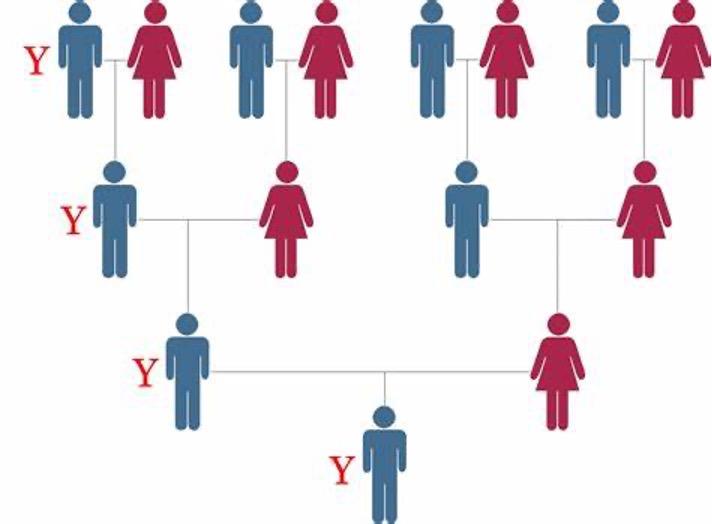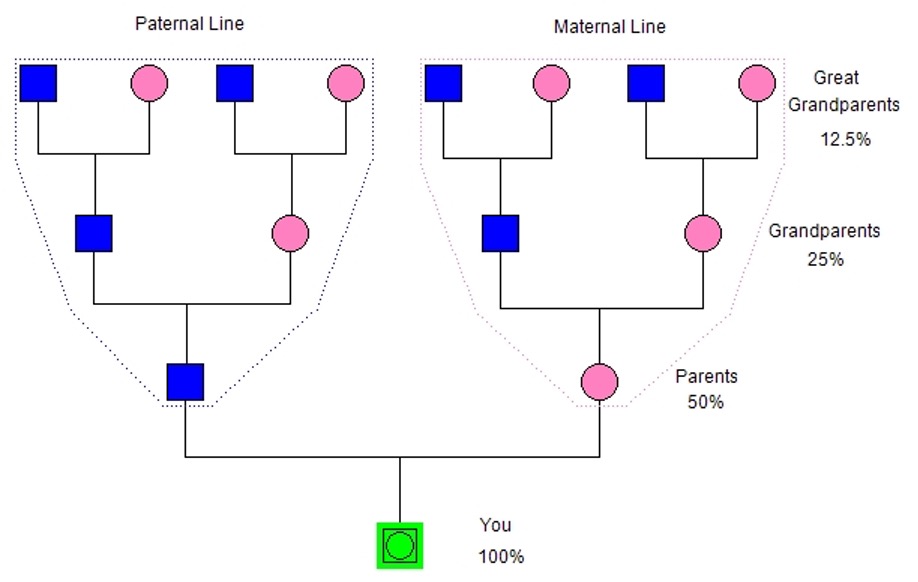How Far Back Can You Go With DNA?
Have you ever wondered how far back you can can trace your ancestry through DNA research? In this article, we'll cover the different types of DNA that can be tested for, and how far back you can trace them.
Many people will take a genetic DNA test with the express purpose of finding out their ethnicity estimate. This is the biggest reason people usually give for buying these tests. Some may be aware of the potential to trace families using tests or discovering their DNA could be the main reason they bought the testing kit.
AncestryDNA is Our Top Recommendation
After reviewing all of the top DNA products on the market, nothing comes close to AncestryDNA to help you discover your whole family story!
They give you so much more than any other family tree DNA kit, and let you connect to the places you're from in the world where your family story started, and even help you to discover living relatives you never knew you had!
For the most accurate family history research based on your DNA, sign up for AncestryDNA now!
Get AncestryDNA →Often those who have a family mystery they are trying to solve with an ancestry based DNA test are looking into recent generations of ancestors. This might include trying to locate an unknown parent, sibling or grandparent.
I know from my own experience with clients that a common question when it comes to tracing DNA relatives is just how far back can we go? The answer may surprise you as depending on the test you take you could conceivably crack some very old family mysteries.
How Far Back Can We Trace DNA Ancestry?
As mentioned, the ability to trace back through our ancestors is very dependent on the types of tests, what DNA we test and how sensitive the tests are. Using most types of testing we can usually find out information from the close generations of our families - parents, grandparents and great grandparents.
There are certain DNA tests that can reach far into the distant past to give us insight into our ancestry. In terms of direct maternal lines, we could trace our ancestry back 150,000 years. With direct paternal lines, it is slightly lesser but not insubstantial at around 60,000 years.
That reach into the past sounds very impressive but we must remember that when we say we can connect DNA to these ancestors we will never really know who they were. There was a 9,000-year-old skeleton found in Cheddar Gorge England. Extracted DNA from this male skeleton proved a match to three local modern-day individuals still in the region.
That was obviously an impressive feat of DNA research but even though those people are descendants of that man from nine millennia ago they would never be able to prove that link in terms of a paper trail. The name of that individual is lost to time although clever facial reconstruction from the skull does put a face to the so-called Cheddar Man.
What Types of DNA Are Tested?
When we send our DNA test kit back to companies such as AncestryDNA or 23andMe they will test specific types of DNA. These may include one or more of the three main types that are associated with genetic inheritance.
- Autosomal DNA
- Y Chromosome (Y-DNA)
- Mitochondrial DNA (mtDNA)
Each of these tests target certain parts of our DNA in order to look for specific results. Using their extensive databases they compare the individual types to that found in their base samples. This is how they can find matches and help us trace our ancestors and close relatives.
How Far Back Does Mitochondrial DNA Trace?
According to most estimates, the DNA type which can potentially take us back the furthest into our ancestral line is mitochondrial DNA. This type of DNA is passed from mother to child regardless of gender so both sons and daughters will receive their mtDNA from their mothers.

A daughter will pass her mother's mtDNA down to her own children although a son can receive but not pass on mitochondrial DNA. This means that the mtDNA inside of us comes from mother to daughter over thousands of years.
The important thing to know about mitochondrial DNA is that unlike other types of DNA such as Y-DNA it tends to mutate at a much slower rate. This means that when we get our mother's mtDNA it is likely 100% the same as she has.
Mutations do still occur because DNA can be a fickle thing at times but these changes are often so slight as to not make a significant impact. These mutations are important, however, to help us understand more about our distant ancestors.
The changes help us trace back to specific regions of the world where scientists assess that these mutations may have originated. It helps give us an idea of whether we had a distant ancestor who lived in Prehistoric Europe, Africa or Asia.
Scientists believe that using mtDNA testing we can trace 100,000 to 200,000 thousand years into our family's past. Of course, as mentioned we would be very unlikely to ever find out who this ancestor was.
It might be possible to find a 200,000-year-old skeleton of a female in good enough condition to retrieve a DNA sample. Science evolves all the time and perhaps one day it could happen. Just like with Cheddar Man we might even find living males or females whose mtDNA matches enough to suggest they are direct descendants.
How Far Back Does Y-DNA Trace?
We have mentioned Y-DNA already in comparison to mtDNA and this is because it has a similar inheritance pattern. Instead of being passed from mother to daughter, though, Y-DNA is passed from father to son. It is important to note that although mtDNA is inherited by sons and daughters Y-DNA is gender-specific.

Women possess two X chromosomes while men have an X and a Y chromosome. That Y chromosome is the one that they inherit from their father, generally completely intact. This is why Y-DNA can be used to help us trace our long-distant male-line ancestors.
Unlike mtDNA, however, Y-DNA is more prone to mutations which is a big reason why it cannot be traced as far back in time. It is estimated that potentially we could trace our Y-DNA back 60,000 to 100,000 years in our family history.
Only males can test their Y-DNA which means women would need a close male blood relative to test on their behalf. The haplogroup that our Y-DNA matches to is what helps us understand our direct paternal male ancestors.
The nature of both mtDNA and Y-DNA are such that they are representative of only about 1% of our ancestral make-up. They both trace either a direct male or female line which ultimately leads to ignoring the vast majority of our ancestors.
How Far Back Can Autosomal DNA Trace?
Our Autosomal DNA is the most limited in terms of tracing back in our family tree. This is the DNA that is found within the vast majority of our chromosomes with the exception of Y and X chromosomes. Unlike mtDNA and Y-DNA our autosomal DNA comes from both of our parents.

We receive roughly 50% of our autosomal DNA from each of our parents who themselves got half of their DNA from each of their parents. This means that autosomal DNA is more representative of our ancestors than Y-DNA or mtDNA.
It should be noted, however, that this type of DNA is most accurate in the most recent generations. We are a combination of our 4 grandparents, 8 great grandparents and 16 great-great-grandparents. However, once we reach great-great-great-grandparents the nature of autosomal DNA inheritance means we might not have any DNA from one of our 32 great-great-great-grandparents.
This is significant because the further we go back into our past the more potential ancestors we might have with whom we do not share any DNA. As a result, autosomal DNA is limited to at most 1,000 years in terms of being able to trace our ancestors.
How to Choose the Right Testing Company
When it comes to autosomal DNA almost all of the testing sites available cover this type of testing in their standard tests. In terms of Y-DNA and mtDNA, this is a more specialized test and some of the main sites do test them but do not tell you much about the results.
The main Y-DNA and mtDNA testing site is Family Tree DNA which offers both testing types and features the largest databases available for both.
Conclusion
Our ability to use DNA to help trace our ancestry is dependent on the type of test we take. Some specialized tests can give us a decent idea of our ancient heritage as far back as 200,000 years, while other types can only trace our family for a few centuries.
We might not be able to make a paper trail record back to our most distant ancestors but using the DNA they left within us we can know where they came from and what ancient people they were associated with.
In very rare cases such as Cheddar Man, we might even see a distant ancestor from thousands of years ago in a facial reconstruction.
Link To or Reference This Page
We spent a lot of time downloading, cleaning, merging, and formatting the data that is shown on the site.
If you found the data or information on this page useful in your research, please use the tool below to properly cite or reference Name Census as the source. We appreciate your support!
-
<a href="https://namecensus.com/blog/how-far-back-can-you-go-with-dna/">How Far Back Can You Go With DNA?</a>
-
"How Far Back Can You Go With DNA?". NameCensus.com. Accessed on April 20, 2024. https://namecensus.com/blog/how-far-back-can-you-go-with-dna/.
-
"How Far Back Can You Go With DNA?". NameCensus.com, https://namecensus.com/blog/how-far-back-can-you-go-with-dna/. Accessed 20 April, 2024
-
How Far Back Can You Go With DNA?. NameCensus.com. Retrieved from https://namecensus.com/blog/how-far-back-can-you-go-with-dna/.
